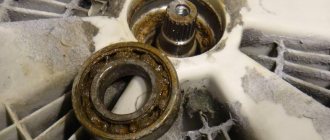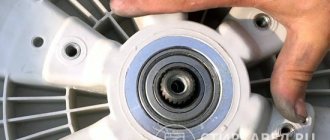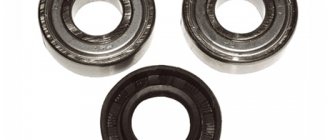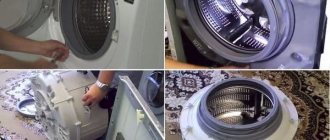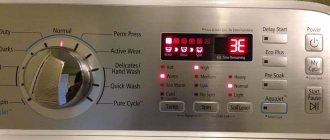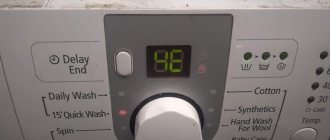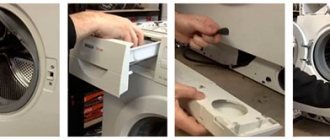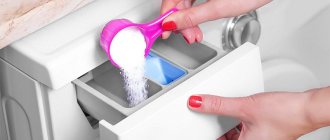How do you know when the bearing in your washing machine needs to be replaced? In the process of washing clothes, it begins to make noise, knock, and squeak. And over time, these unpleasant sounds will only intensify. If you do not replace the bearing in time, then it will be much more difficult to do it later. Also, if the bearing is not changed in a timely manner, the washing machine may completely break down and will no longer be repairable. The best option is to immediately replace it with a new one if a bearing is damaged.
Replacing a bearing on your own will not be easy or quick at all. Therefore, before changing it, you need to decide whether you can do all the necessary work with your own hands? If such work is beyond your capabilities, then it is better to call a specialist. Replacing the bearing, including the cost of the new part, will cost you about a third of the cost of a new washing machine. Of course, today there are different prices for household appliances and their repairs, and therefore the cost of repairs given by us is conditional.
So, if you decide to do the repairs yourself, then let’s take a closer look at how to do it.
Preparation for repair
Repairing a washing machine yourself begins with preparing the necessary tools and spare parts. Remember, the further life of the automatic machine depends on the quality of spare parts; for this reason, do not purchase cheap analogues, give preference to original parts. So, you will need:
- Hammer
- Open-end wrenches of various sizes
- Pliers
- Metal pin
- Screwdriver Set
- Silicone based sealant
- Water-repellent grease or lithol
- Camera
- 2 bearings
- Stuffing box
In order to be guaranteed to purchase exactly the bearing you need, you must first remove the old one and select an identical one with it. You may need a camera to make the process of assembling your repaired car easier. Before disassembling a particular area, take a photo of it and then you will know exactly how to reassemble it after repair. When shooting, pay special attention to wiring connections.
Before replacing the bearing in your washing machine, make sure that regular lubrication will not fix the problem.
It often happens that the washing machine begins to rattle due to the thinning of the lubricant layer. How to lubricate a bearing in a washing machine? To lubricate this element, it must be freed from the protective covers using a scalpel. Carefully remove the cover. Lubricate the part with a special waterproof lubricant for washing machines. Next, take a new oil seal, also treat it with lubricant and install. Close the lid. If after these steps the noise is not eliminated, the bearing must be replaced. See also -
How and with what to lubricate the oil seal of a washing machine
Signs of bearing failure
Breakdowns depend on various factors, including the build quality of the equipment and its age.
Trouble can happen for the following reasons:
- due to a worn oil seal, the bearing assembly is destroyed by moisture;
- the rules for installing the washing machine were violated (instructions for proper installation are given here);
- regular tank overload.
Another possible problem is the initially poor quality of the bearings themselves.
It is often possible to find out about a breakdown even by hearing.
The signs that a bearing unit is malfunctioning are eloquently signaled by the following signs:
- the drum does not spin after turning on the washing program, although the motor is running (other reasons for such a breakdown are discussed in this article);
- the drum rotates, but makes an atypical grinding noise, and sometimes a rumble, the washing machine vibrates significantly;
- washed clothes are not spun (we talked more about noise and lack of spin in another article).
Having decided to deal with such an obstacle on your own, you need to clearly understand that this is a very labor-intensive process related to a major overhaul, in which virtually the entire washing machine must be disassembled.
You can make sure that there is a problem in the bearing by turning off the power to the washing machine and trying to rotate the drum in different directions by hand. The knocking and grinding sounds that appear in response will confirm suspicions
When the final decision is made to fix the breakdown yourself, in order not to aggravate the situation, you need to stop using the faulty mechanism and start preparing for repairs.
Stage one - disassembling the washing machine
First you need to remove the cover of the device. This is done quite simply. You should unscrew the two bolts on the rear side panel of the cover and simply lift it by sliding it back a little.
Next, you need to remove the laundry detergent tray. Pull the tray towards you and press the special latch, while pulling the powder receptacle towards you. These actions should release the tray, and it will easily come out of the grooves. Some models do not have such a button, then you just need to pull the tray, pressing it down a little.
To remove the upper instrument panel, you need to carefully inspect it.
Determine where the mounting bolts for this panel are located in your model and remove them all. If the panel does not come off easily after this, you have missed one or more bolts. After the panel cover is unscrewed and comes out easily, you should disconnect all the wires from the sockets and completely remove the element. Don't forget to take pictures of all parts during disassembly. Next we move on to removing the bottom panel. The process should not be difficult. Using a flat-head screwdriver, press the latches that hold the bar in place and it will easily release. See also -
Replacing the cuff on a washing machine with your own hands
How much does a master's work cost?
If you cannot cope with replacing the bearing on your own, you should contact a specialist. You can find a specialist by looking at an ad in a newspaper or on the Internet. Another option is to contact a service center. If the machine is under warranty, the repairs must be paid for by the manufacturer of the household appliance.
In a workshop, bearings are inserted using a special press, so it will be installed efficiently and will not fly out of the socket. The cost of repair work starts from 3,300 rubles.
To minimize the risk of encountering scammers, you need to contact trusted professionals or large service centers with a positive reputation. You also need to check with a specialist in advance how much the repair will cost.
Stage two - remove the hatch cuff
The cuff is a special rubber gasket that connects the hatch opening and the laundry drum. It is attached very simply with a spring and a clamp. To release the cuff and gain access to removing the entire front panel, you need to find a clamp. It can be detected visually. To remove it, use a flat-head screwdriver to pry up the spring and pull out the clamp. Afterwards, carefully remove the cuff from the hatch hole and place it in the drum. Now the part we need is completely free, we can begin to dismantle it.
Stage four - remove the tank
First you need to get rid of the inner top panel. First of all, you need to inspect the back of the machine and find the screws that secure the water supply valve. Having unscrewed these fasteners, you can begin to tighten the bolts on the panel. Do not rush to remove it, because you still need to carefully disconnect all the wires and pipes. Once everything is disconnected, you can remove the panel itself.
Next we move on to disconnecting the drain pipe. It is connected to the washing machine tank using a clamp. Unscrew the clamp and disconnect the drain pipe. After this, we proceed to disconnect the heating element. In different models it can be located in front or behind the structure. If your tubular electric heater (TEH) is located in the back, you will need to remove the back wall. Carefully disconnect all connections going to the heating element. Don't forget to take pictures of the original state before doing this. At this stage, the wiring must be completely disconnected. Please note that in some places it may be attached to parts of the machine using different fasteners. Having disconnected all the wires, pull them out.
We get rid of counterweights. This must be done so that the tank is not too heavy. Carefully unscrew them. Then disconnect the water level sensor. Shock absorbers can be detached. Armed with a wrench, unscrew the bolts holding these parts. For these jobs, it is best to use a nozzle with an extension.
Keep in mind that the tank itself is lightweight, so you don't need to put much effort into removing it. Reach one hand into the tank and lift it up. With your other hand, release the container from the springs on which it is attached. After this you can pull it out.
The final step is to remove the belt, unscrew the engine and shock absorbers. Once completely freed, the reservoir can be disassembled to replace the bearing.
Assembling the machine
The last step in replacing bearings on an automatic machine will be to assemble the structure, which is carried out in the reverse order. This is where a recording of the disassembly of a washing unit will come in handy for novice craftsmen and professional repairmen.
Assembly is carried out very carefully, and vulnerable areas, especially in the area where the two halves of the tank are connected, must be treated with silicone sealant.
Before carrying out a test wash, you must wait until the sealant has completely dried.
Stage five - disassemble the tank
Once the tank is released, you may notice that it consists of two halves. These halves are fastened together along the entire perimeter of the connection. Fastenings depend on the brand and model of the washing machine; these can be bolts or special latches. You need to separate the halves. We act depending on the type of fastenings. After removing the front part, you can often observe the presence of debris and dirty deposits. It is advisable to get rid of dirt before assembly. On the back half you will see a drum. This is precisely our goal.
This stage is the most critical and requires increased attention and caution. We need to carefully disconnect the drum. First of all, remove the pulley. Simply unscrew the fasteners holding this part in place and remove the pulley from the axle. After removing the pulley, screw the screw back in. At the same time, we spare no effort so as not to damage the shaft during further work.
We take a hammer. At this stage there is no need to be zealous, proceed carefully. We are trying to gradually knock out the shaft. If these manipulations are in vain and the shaft remains in place, it is better to replace the bolt to avoid damage. We keep knocking. As soon as the shaft is level with the top of the bolt, remove the bolt and pull out the drum.
We proceed to a visual inspection of the bushing and shaft. Often, if repairs are not carried out in a timely manner, these spare parts can wear out so much that the crosspiece has to be replaced. In order to assess the condition of the shaft, it should be wiped with a dry, clean cloth. After this, carefully inspect it from all sides for the presence of workings. To be completely sure of the integrity of the shaft, put a new bearing on it and determine if there is any play. If you still notice a flaw, change the shaft with the cross without hesitation.
Next, inspect the bushing. It is located on the shaft and is intended for fitting the oil seal. The bushing should also not show signs of severe wear and mechanical damage. If you find very pronounced transverse grooves, such a part will no longer be able to perform its functions. An oil seal placed on such a bushing will not be able to protect the bearing from water, and the repair will need to be done again.
What happens if a faulty bearing is not replaced?
A broken bearing is always unpleasant, since it is quite difficult to replace it, but, nevertheless, it must be done. The consequences can lead to serious problems if measures are not taken in time:
- The bearing seat will break and you will have to install a new drum.
- The electric motor will burn out and will have to be replaced.
- The belt drive may break.
- The units responsible for transmitting the rotational motion of the electric motor shaft to the drum of the washing machine may fail.
- The integrity of the tank will be compromised, this is especially true for equipment where it is made of plastic. Water may leak, the electronic control system may be damaged, but the most unpleasant thing is that you will flood your neighbors.
Stage six - replacing bearings
To remove the bearings you need to remove the seal. It comes out very easily. Using a flathead screwdriver, pry up the oil seal and remove it. Next, we pick up a metal pin. With its help we will knock out these elements. Having placed the pin to the bearing, we hit it with a hammer. Then we make the blow opposite, the blows should be in the form of a cross, on four sides of the part. With this simple technique you can knock out both bearings.
When performing these manipulations, keep in mind that the smaller bearing must be knocked out from the inside, and the larger one from the outside of the tank. Also, when performing this work, be extremely careful not to damage the product. It is best to knock out the piece while leaning on one knee.
Upon completion of this stage, pay attention to the back wall and the places where the bearings fit. These areas should be free of dirt or debris. They should not only be cleaned, they should be polished to a shine. Only in this case you will not have to repair the car again for a long time.
Well, it's time to unpack the new bearings. We take the smaller one and hammer it in place of the one removed. We also apply the metal pin to opposite sides and hammer it in with light blows of a hammer. In order to determine whether the element has settled into place, listen carefully to the sound of the next blow. When the part fits properly, the sound will be louder.
We carry out a similar operation to change the large bearing. Next we move on to installing the new oil seal. It must be treated with lubricant, only after this the oil seal can be placed in place. Experts advise using special lubricants designed for washing machines. However, such lubricants are not always available for sale. If you cannot find lubricant, you can use lithol grade 24. This material is freely sold in automobile stores.
